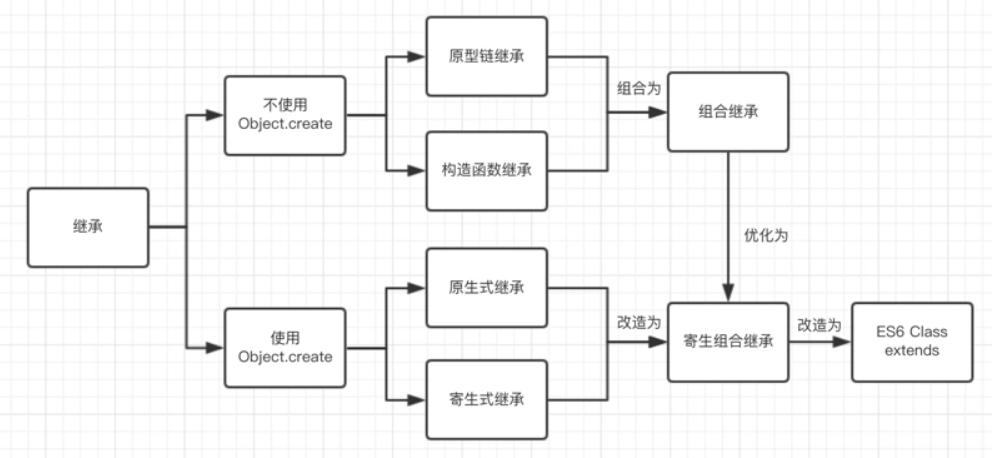
如果使用了直接对象字面量方式,会破坏继承以及原型链
这里我们提前讲一下 new 与 object.create() 来源
new XisObject.create(X.prototype)with additionally running theconstructorfunction. (And giving theconstructorthe chance toreturnthe actual object that should be the result of the expression instead ofthis.)
new Test():
- create
new Object()obj- set
obj.__proto__toTest.prototypereturn Test.call(obj) || obj; // normally obj is returned but constructors in JS can return a value
Object.create( Test.prototype )
- create
new Object()obj- set
obj.__proto__toTest.prototypereturn obj;
So basically
Object.createdoesn’t execute the constructor.
对于继承! 核心是 原型链
1.原型链继承
原理:将子类的原型挂载到父类上;
优点:父类方法可以继承使用
缺点:
- 子类new出来的实例不能向父类构造函数传递参数;
- 父类的引用属性没隔离,会相互影响;不能多继承
- 子类对象不能指向自己constructor
语法
// 父类
function Parent(){}
// 子类
function Child(){}
// 继承
Child.prototype = new Parent();
//Child.prototype.constructor =>>>> ƒ Parent() {}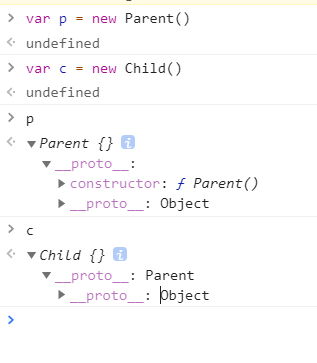
例子
function parent(){
this.flag = true
}
parent.prototype.getParentValue = function(){
return this.flag
}
console.log(parent.prototype)
function child(){
this.flag1 = false
} //创建一个构造函数child
child.prototype = new parent() //让child通过创建实例,继承parent
console.log(child.prototype) //child的原型就是parent函数
child.prototype.getChildValue = function(){
return this.flag1
}
/* 下面是错误的写法!!! 这样= 掐断原生链
Child.prototype = {
getChildValue:function () {
return this.Childproperty
}
}
*/
let instance = new child()
console.log(instance.getParentValue()) //true 原型链继承有一个缺点,就是属性如果是引用类型的话,会共享引用类型
// 父类
function Person() {
this.hobbies = ['music','reading']
}
// 子类
function Student(){}
// 继承
Student.prototype = new Person()
var stu1 = new Student()
var stu2 = new Student()
stu1.hobbies.push('basketball')
console.log(stu1.hobbies) // music,reading,basketball
console.log(stu2.hobbies) // music,reading,basketball2.盗用构造函数(经典继承)
原理:在子类的构造函数里调用父类的构造函数,通过使用apply()和call()方法将父类构造函数的内容复制给了子类的构造函数。这是所有继承中唯一一个不涉及到 prototype的继承。
优点: 和原型链继承完全反过来 ; 父类的引用属性不会被共享 ; 子类构建实例时可以向父类传递参数,可以多继承(call 多个父类)
缺点:
- 子类只是接用父类的构造函数,父类原型的属性方法对子类不可见
- 必须在构造函数中定义方法,函数不能重用(构造函数模式的缺点)
语法
// 父类
function Parent() {}
//子类
function Child(){
Parent.call(this);//重新执行一遍parent函数
}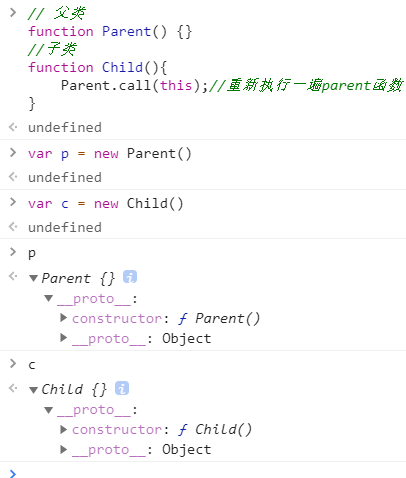
例子
function Person(name){
this.name = name;
this.hobbies = ['music','reading'];
this.say = function() {};
}
function Student(name){
Person.call(this,name);
this.age = 29;
}
var stu1 = new Student("Nicholas")
var stu2 = new Student("lucy")
stu1.hobbies.push('basketball')
alert(stu1.name); //"Nicholas"
alert(stu1.age); //29
console.log(stu1.hobbies) // music,reading,basketball
console.log(stu2.hobbies) // music,reading
console.log(stu1.say === stu2.say) // false 子类没有办法共享父类的函数3.组合继承 ( 原型链+构造函数 ) - 最常用的模式
原理:原型式继承和构造函数继承的组合,兼具了二者的优点。
优点: 传参和复用:父类的方法可以被复用 ; 父类的引用属性不会被共享 ; 子类构建实例时可以向父类传递参数
缺点:多次调用父类构造函数,性能浪费
语法
//父类
function Parent(name){ this.name=name}
//子类
function Child(name){ Parent.call(this,name)}
// 继承
Child.prototype = new Parent();
//Child.prototype.constructor === Child() //falase 是Parent
//Child.prototype.constructor = Child//这个本身没有 但是使用上基本优化还是要有 下面的图是没有的状况(这里是按照红宝石的书本)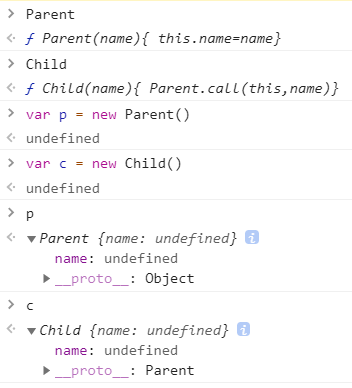
例子
// 父类
function Person(name) {
this.name=name;
this.hobbies = ['music','reading']
}
// 父类函数
Person.prototype.say = function() {console.log('I am a '+ this.name)}
// 子类
function Student(name,age){
Person.call(this,name) // 构造函数继承(继承属性) - 调用了1次父类构造函数
this.age=age;
}
// 继承
Student.prototype = new Person() // 原型链继承(继承方法) - 调用了2次父类构造函数
//子类函数
Student.prototype.sayAge = function(){ alert(this.age); }
// 实例化
var stu1 = new Student("Nicholas",23)
var stu2 = new Student("lucy",12)
stu1.hobbies.push('basketball')
console.log(stu1.hobbies) // music,reading,basketball
console.log(stu2.hobbies) // music,reading
console.log(stu1.say == stu2.say) // true
stu1.sayName(); //"Nicholas"
stu1.sayAge(); //23组合继承优化1?
原理:这种方式通过父类原型和子类原型指向同一对象
优点:子类可以继承到父类的公有方法当做自己的公有方法,而且不会初始化两次实例方法/属性,避免的组合继承的缺点。
缺点:没办法辨别是对象是子类还是父类实例化
语法
//父类
function Parent(){}
//子类
function Child(){ Parent.call(this)};
// 继承
Child.prototype = Parent.prototype;例子
function Person(name, age) {
this.name = name,
this.age = age,
this.setAge = function () { }
}
Person.prototype.setAge = function () {
console.log("111")
}
function Student(name, age, price) {
Person.call(this, name, age)
this.price = price
this.setScore = function () { }
}
Student.prototype = Person.prototype;
Student.prototype.sayHello = function () { }
var s1 = new Student('Tom', 20, 15000)
console.log(s1)组合继承优化2 (推荐使用) - Object.create?
原理:借助原型可以基于已有的对象来创建对象,var B = Object.create(A)以A对象为原型,生成了B对象。B继承了A的所有属性和方法。
语法
//父类
function Parent(){}
//子类
function Child(){ Parent.call(this)};
// 继承
Child.prototype = Object.create(Parent.prototype)//核心代码
Child.prototype.constructor = Child//核心代码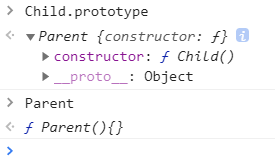
例子
function Person(name, age) {
this.name = name,
this.age = age
}
Person.prototype.setAge = function () {
console.log("111")
}
function Student(name, age, price) {
Person.call(this, name, age)
this.price = price
this.setScore = function () {}
}
Student.prototype = Object.create(Person.prototype)//核心代码
Student.prototype.constructor = Student//核心代码
var s1 = new Student('Tom', 20, 15000)
console.log(s1 instanceof Student, s1 instanceof Person) // true true
console.log(s1.constructor) //Student
console.log(s1)4.原型式继承
核心:原型式继承的object方法本质上是对参数对象的一个浅复制。本方法的出发点是即使不自定义类型也可以通过原型实现对象之间的信息共享
优点:1. 不需要单独创建构造函数,但仍有对象之间的共享信息;2. 每一个新增对象有自己的属性
缺点: 对象的引用属性会被共享(跟原型模式一样)
图解与语法
function object(o){ //一个临时构造函数
function F(){};
F.prototype = o;
return new F();
}
let parent = {name:"name",func1:function(){console.log("this is ")}}
var Child = object(parent);
//var Child = Object.create(parent) 同效果
例子
/*clone 内部首先是创建了一个空的构造函数F,然后把F的prototype指向参数proto,最后返回一个F的实例对象,完成继承. 最好看图 */
//本质上讲,就是对传入的对象执行了一次浅复制
var person = {
name:"Nicholas",
friends:["Shelby","Court","Van"]
};
var anotherPerson = object(person);
anotherPerson.name = "Greg";
anotherPerson.friends.push("Rob");
var yetAnotherPerson = object(person);
yetAnotherPerson.name = "Linda";
yetAnotherPerson.friends.push("Barbie");
alert(person.friends); //"Shelby,Court,Van,Rob,Barbie"
alert(anotherPerson.friends); //"Shelby,Court,Van,Rob,Barbie"
alert(yetAnotherPerson.friends); //"Shelby,Court,Van,Rob,Barbie"
Object.create()方法
基本用法和上面的object一样,除了object不能接受第二个参数以外
var person = {
name:"Nicholas",
friends:["Shelby","Court","Van"]
};
var anotherPerson = Object.create(person,{name:{value:"Lily"}})
console.log(anotherPerson.friends) // ["Shelby", "Court", "Van"]
console.log(anotherPerson.name)//"Lily"5. 寄生式继承- parasitic inheritance
核心:主要考虑对象而 不是自定义类型和构造函数的情况下
原理:类似寄生构造函数与工厂模式,创建一个仅用于封装继承过程的函数,该函数在内部以某种形式来做增强对象,最后返回对象
优点: 不在乎类型与构造函数
缺点:跟借用构造函数模式一样,每次创建对象都会创建一遍方法。难复用函数
例子
function createAnother(original){
var clone = object(original);//object()函数创建对象
// 或者用var clone =Object.create(original) 是一样的
clone.sayHi = function(){ //增强这个对象 (就是给这个对象增加一些其他方法)
alert("hi");
};
return clone; //返回这个对象
}
var person = {
name:"Nicholas",
friends:["Shelby","Court","Van"]
}
var anotherPerson = createAnother(person); //新对象(不仅拥有了person的属性和方法,而且还拥有了自己的sayHi方法)
anotherPerson.sayHi(); //"hi" 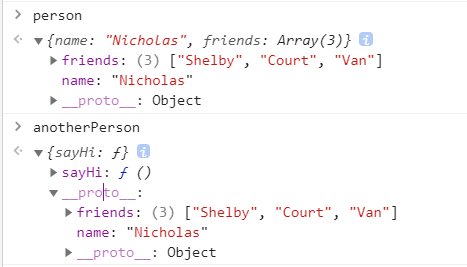
6. 寄生组合式继承(推荐)
核心:通过借用构造函数来继承属性,通过原型链的混成(寄生办法)形式来继承方法
优点:这种方式的高效率体现它只调用了一次 Parent 构造函数,并且因此避免了在 Parent.prototype 上面创建不必要的、多余的属性。与此同时,原型链还能保持不变;因此,还能够正常使用 instanceof 和 isPrototypeOf。开发人员普遍认为寄生组合式继承是引用类型最理想的继承范式。
缺点:本来会出现至少两次调用parent 构造函数(一次是设置子类型实例的原型的时候;一次在创建子类型实例的时候;);但是封装inheritPrototype()之后就不会有
语法
//封装前
function SuperType(name){
this.name = name;
this.colors = ["red", "blue", "green"];
}
SuperType.prototype.sayName = function(){
alert(this.name);
};
function SubType(name, age){
// 继承属性
SuperType.call(this, name); // 第二次调用SuperType()
this.age = age;
}
// 继承方法
SubType.prototype = new SuperType(); // 第一次调用 SuperType()
SubType.prototype.constructor = SubType;
SubType.prototype.sayAge = function(){
alert(this.age);
};//这里的例子是封装之后
//第一步 是创建父类原型的一个副本,然后给返回的prototype对象设置constructor属性
//第二步 是解决由于重写原型导致默认constructor丢失的问题,constructor的指向问题(改不改都不影响),原来返回的F.constructor指向parent,要修改为指向child
function inheritPrototype(Child, Parent) {// 这个函数是关键
var prototype = Object.create(Parent.prototype);// 创建了父类原型的浅复制;或者之前的object()方法
console.log(prototype);
prototype.constructor = Child;// 修正原型的构造函数
Child.prototype = prototype;// 将子类的原型替换为这个原型
}
//父类创建
function Parent() {}
Parent.prototype.sayName = function () {}
//子类
function Child() {}
// 核心:因为是对父类原型的复制,所以不包含父类的构造函数,也就不会调用两次父类的构造函数造成浪费
//避免使用 child.prototype = new parent()来继承整个parent实例
inheritPrototype(Child, Parent);//继承
var instance = new Child()00
instance.sayName()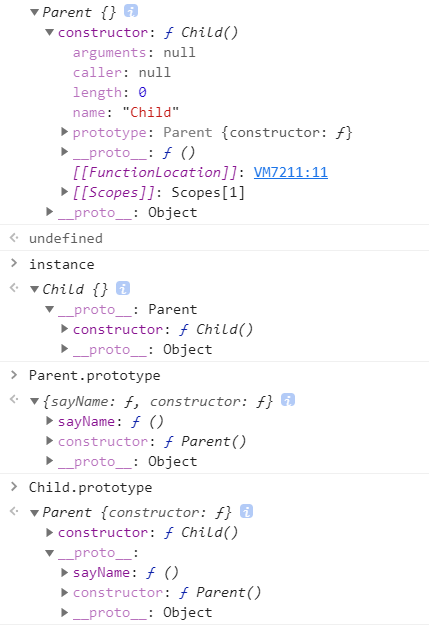
例子
function inheritPrototype(Child, Parent) {// 这个函数是关键
var prototype = Object.create(Parent.prototype);// 创建了父类原型的浅复制;或者之前的object()方法
prototype.constructor = Child;// 修正原型的构造函数
Child.prototype = prototype;// 将子类的原型替换为这个原型
}
//父类创建
function Parent(name) {
this.name = name
this.colors = ["red", "blue", "green"]
}
Parent.prototype.sayName = function () {
console.log(this.name)
}
//子类
function Child(name, job) {
// 继承属性
Parent.call(this, name)
this.job = job
}
// 核心:因为是对父类原型的复制,所以不包含父类的构造函数,也就不会调用两次父类的构造函数造成浪费
//避免使用 child.prototype = new parent()来继承整个parent实例
inheritPrototype(Child, Parent);//继承
var instance = new Child("Jiang", "student")
instance.sayName()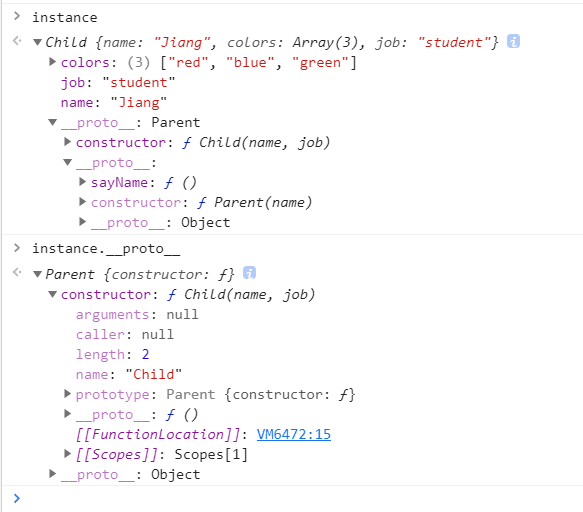
7. ES6 Class extends
核心: ES6继承的结果和寄生组合继承相似,本质上,ES6继承是一种语法糖。但是,寄生组合继承是先创建子类实例this对象,然后再对其增强;而ES6先将父类实例对象的属性和方法,加到this上面(所以必须先调用super方法),然后再用子类的构造函数修改this。
定义
// class declaration
class Person {}
// class expression
const Animal = class {};语法
class A {}
class B extends A {
constructor() {
super();
}
}例子
class Parent{
constructor(){
this.name = 'Parent';
this.arr = [1, 2, 3];
}
say(){
console.log(this.name);
}
}
class Child extends Parent{
constructor(){
super(); //通过super()调用父类构造函数
this.type="Child";
}
}
let child_1 = new Child()
let child_2 = new Child()
child_1.arr.push(4);
console.log(child_1.say()) // Parent
console.log(child_1.arr, child_2.arr) // [1, 2, 3, 4] [1, 2, 3]
console.log(child_1.constructor === Child) // true
console.log(child_2.constructor === Parent) // false总结
- 原型链 的问题是所有继承的树形和方法都会在对象视力健共享,无法做到实例私有。
- 盗用构造函数 模式通过在子类构造函数中调用父类构造函数,可以避免这个问题。这样可以让每个实例竭诚的树形都是私有的,但要求类型只能通过构造函数模式来定义(因为子类不能访问父类原型上的方法)。
- 组合继承 最为流行,即通过原型链继承共享的属性和方法,通过盗用构造函数来继承实例属性。
- 原型式继承 可以无需明确定义构造函数二实现继承,本质上是对给定对象执行浅复制,这个操作的结构之后还可以再进一步增强。
- 寄生式继承 与原型式继承密切相关,即先基于一个对象创建一个新对象,然后再增强这个新对象,最后返回新对象,这个模式也被用在组合继承中,用于避免重复调用父类构造函数导致的浪费。
- 寄生组合继承 被认为是实现基于类型继承的最有效的方式。
Reference
- https://segmentfault.com/a/1190000014476341
- 《JavaScript 高级程序设计》

